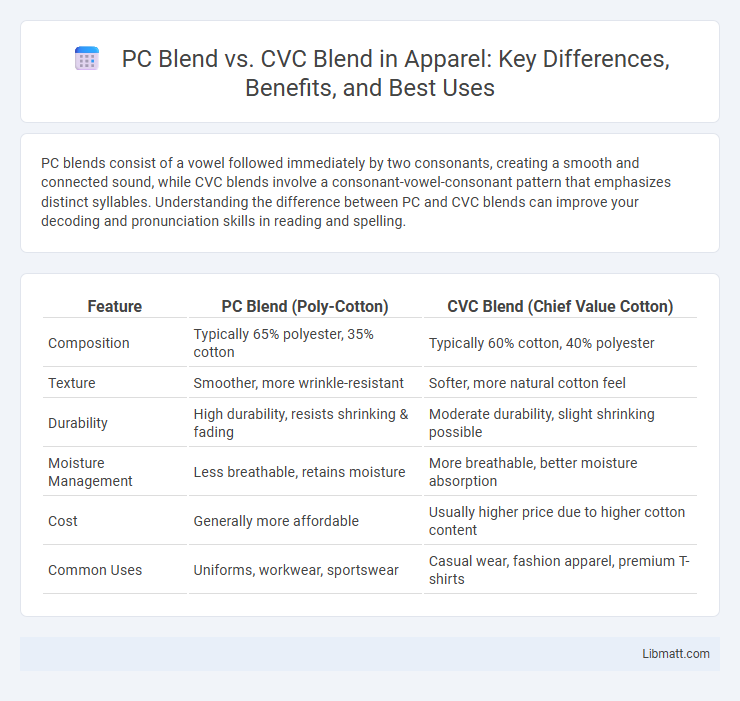PC blends consist of a vowel followed immediately by two consonants, creating a smooth and connected sound, while CVC blends involve a consonant-vowel-consonant pattern that emphasizes distinct syllables. Understanding the difference between PC and CVC blends can improve your decoding and pronunciation skills in reading and spelling.
Table of Comparison
| Feature | PC Blend (Poly-Cotton) | CVC Blend (Chief Value Cotton) |
|---|---|---|
| Composition | Typically 65% polyester, 35% cotton | Typically 60% cotton, 40% polyester |
| Texture | Smoother, more wrinkle-resistant | Softer, more natural cotton feel |
| Durability | High durability, resists shrinking & fading | Moderate durability, slight shrinking possible |
| Moisture Management | Less breathable, retains moisture | More breathable, better moisture absorption |
| Cost | Generally more affordable | Usually higher price due to higher cotton content |
| Common Uses | Uniforms, workwear, sportswear | Casual wear, fashion apparel, premium T-shirts |
Introduction to PC Blend and CVC Blend
PC Blend refers to a fabric composed primarily of polyester and cotton fibers, combining the durability and wrinkle resistance of polyester with the breathability and softness of cotton. CVC Blend, or Chief Value Cotton Blend, contains a higher percentage of cotton compared to polyester, enhancing comfort while maintaining some strength and easy care qualities from polyester. Both blends offer unique advantages tailored for various textile applications, balancing comfort, cost, and performance.
Composition: What Are PC Blend and CVC Blend?
PC Blend refers to fabrics combining polyester and cotton, typically with a higher polyester content, enhancing durability and wrinkle resistance. CVC Blend stands for Chief Value Cotton, consisting mainly of cotton with a smaller percentage of polyester, which improves comfort and breathability while maintaining fabric strength. Both blends optimize fabric performance by balancing the natural softness of cotton with the resilience of polyester.
Key Differences Between PC Blend and CVC Blend
PC Blend combines polyester and cotton fibers providing enhanced durability and wrinkle resistance, ideal for uniforms and workwear. CVC Blend, consisting of a higher percentage of cotton with polyester, offers superior breathability and comfort, making it suitable for casual wear and everyday clothing. The key difference lies in fiber composition ratio impacting fabric performance: PC Blend prioritizes durability while CVC Blend emphasizes softness and moisture absorption.
Physical Properties Comparison
PC Blend and CVC Blend differ significantly in physical properties, impacting their performance in various applications. PC Blend typically exhibits higher heat resistance, superior strength, and better impact toughness compared to CVC Blend, which tends to be softer and more flexible due to its cotton composition. Understanding these physical property differences can help you select the optimal material blend for durability and comfort in textile manufacturing or product design.
Durability and Longevity
PC Blend fabrics, known for incorporating polyester and cotton, offer excellent durability due to polyester's resistance to shrinking, stretching, and wrinkling, extending the garment's lifespan significantly. CVC Blend, combining a higher percentage of cotton with polyester, provides enhanced breathability while maintaining reasonable durability but is generally less resistant to wear and tear compared to PC Blend. The longevity of PC Blend fabrics makes them ideal for heavy-use clothing requiring sustained shape and color retention, whereas CVC Blends are better suited for comfort in everyday casual wear with moderate durability.
Comfort and Feel
PC blend materials typically offer a smooth and soft texture, making them highly comfortable for prolonged wear due to their breathability and moisture-wicking properties. CVC blends, composed predominantly of cotton with some polyester, provide a natural, soft feel but may be less durable and slightly less moisture-efficient compared to PC blends. The choice between PC and CVC blends hinges on the balance between comfort, texture, and performance needs for specific clothing or textile applications.
Common Uses in Apparel and Textiles
PC blend fabrics, combining polyester and cotton, are commonly used in casual wear, uniforms, and workwear due to their durability, breathability, and ease of care. CVC blend textiles, with a higher cotton content than polyester, offer a softer feel and better moisture absorption, making them ideal for everyday apparel like t-shirts, shirts, and lightweight jackets. Both blends enhance fabric performance by balancing comfort, durability, and cost-effectiveness in various textile applications.
Care and Maintenance Guidelines
PC Blend fabrics require gentle washing with cold water and mild detergents to prevent fiber damage and preserve fabric strength, avoiding bleach and high heat during drying. CVC Blend materials benefit from machine washing in warm water and low heat drying to maintain color vibrancy and fabric softness while minimizing shrinkage. Both blends should be ironed at medium temperatures and stored in a cool, dry place to extend garment longevity and appearance.
Environmental Impact and Sustainability
PC blend materials often contain a significant proportion of polycarbonates, which are less biodegradable and can contribute to long-term plastic pollution. CVC blends, typically composed of cellulose, viscose, and cotton, offer increased biodegradability and renewable sourcing, reducing environmental impact through faster decomposition and lower carbon footprint. The sustainability of CVC blends is enhanced by their use of natural fibers, promoting eco-friendly textile production and waste management compared to synthetic-heavy PC blends.
Which Blend Is Right for You?
PC Blend fabrics offer a mix of polyester and cotton that balances durability and breathability, making them ideal for uniforms and everyday wear where comfort and resilience matter. CVC Blend, with a higher cotton content, provides a softer feel and better moisture absorption, perfect for casual or summer clothing that prioritizes comfort. Your choice depends on whether you value strength and wrinkle resistance (PC Blend) or softness and breathability (CVC Blend).
PC Blend vs CVC Blend Infographic

 libmatt.com
libmatt.com